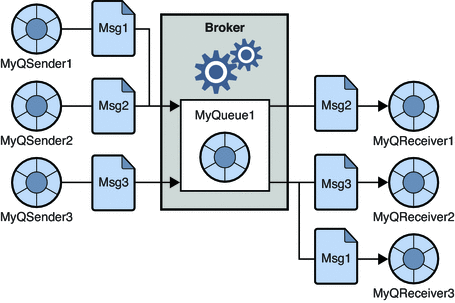Point-To-Point Messaging
In the point-to-point domain, message producers are called senders and consumers are called receivers. They exchange messages by means of a destination called a queue: senders produce messages to a queue; receivers consume messages from a queue. What distinguishes point-to-point messaging is that a message can be consumed by only one consumer.
Figure 2–1 shows the simplest messaging operation in the point-to-point domain. MyQueueSender sends Msg1 to the queue destination MyQueue1. Then, MyQueueReceiver obtains the message from MyQueue1.
Figure 2–1 Simple Point-to-Point Messaging

Figure 2–2 shows a more complex picture of point-to-point messaging to illustrate the possibilities offered by this domain. Two senders, MyQSender1 and MyQSender2, use the same connection to send messages to MyQueue1. MyQSender3 uses an additional connection to send messages to MyQueue1. On the receiving side, MyQReceiver1 consumes messages from MyQueue1, and MyQReceiver2 and MyQReceiver3, share a connection in order to consume messages from MyQueue1.
Note –
Support for multiple-consumer queues is a Message Queue feature (the JMS specification defines messaging behavior in the case of only one consumer accessing a queue). When multiple consumers access a queue, the load-balancing among them takes into account each consumer’s capacity and message processing rate.
Figure 2–2 Complex Point-to-Point Messaging

This more complex picture exemplifies a number of additional points about point-to-point messaging.
-
More than one sender can produce and send messages to a queue. Senders can share a connection or use different connections, but they can all access the same queue.
-
More than one receiver can consume messages from a queue, but each message can be consumed by only one receiver. Thus Msg1, Msg2, and Msg3 are consumed by different receivers. (This is a Message Queue extension.)
-
Receivers can share a connection or use different connections, but they can all access the same queue. (This is a Message Queue extension.)
-
Senders and receivers have no timing dependencies: the receiver can consume a message whether or not it was running when the sender produced and sent the message.
-
Messages are placed in a queue in the order they are produced, but the order in which they are consumed depends on factors such as message expiration date, message priority, whether a selector is used in consuming messages, and the releative message processing rate of the consumers.
-
Senders and receivers can be added and deleted dynamically at runtime, thus allowing the messaging system to expand or contract as needed.
The point-to-point domain offers a number of advantages:
-
Messages destined for a queue are always retained, even if there are no receivers.
-
Java clients can use a queue browser object to inspect the contents of a queue. They can then consume messages based on the information gained from this inspection. That is, although the consumption model is normally FIFO (first in, first out), receivers can consume messages that are not at the head of the queue by using message selectors. Administrative clients can also use the queue browser to monitor the contents of a queue.
-
The fact that multiple receivers can consume messages from the same queue allows you to use load-balancing to scale message consumption if the order in which messages are received is not important.
- © 2010, Oracle Corporation and/or its affiliates
